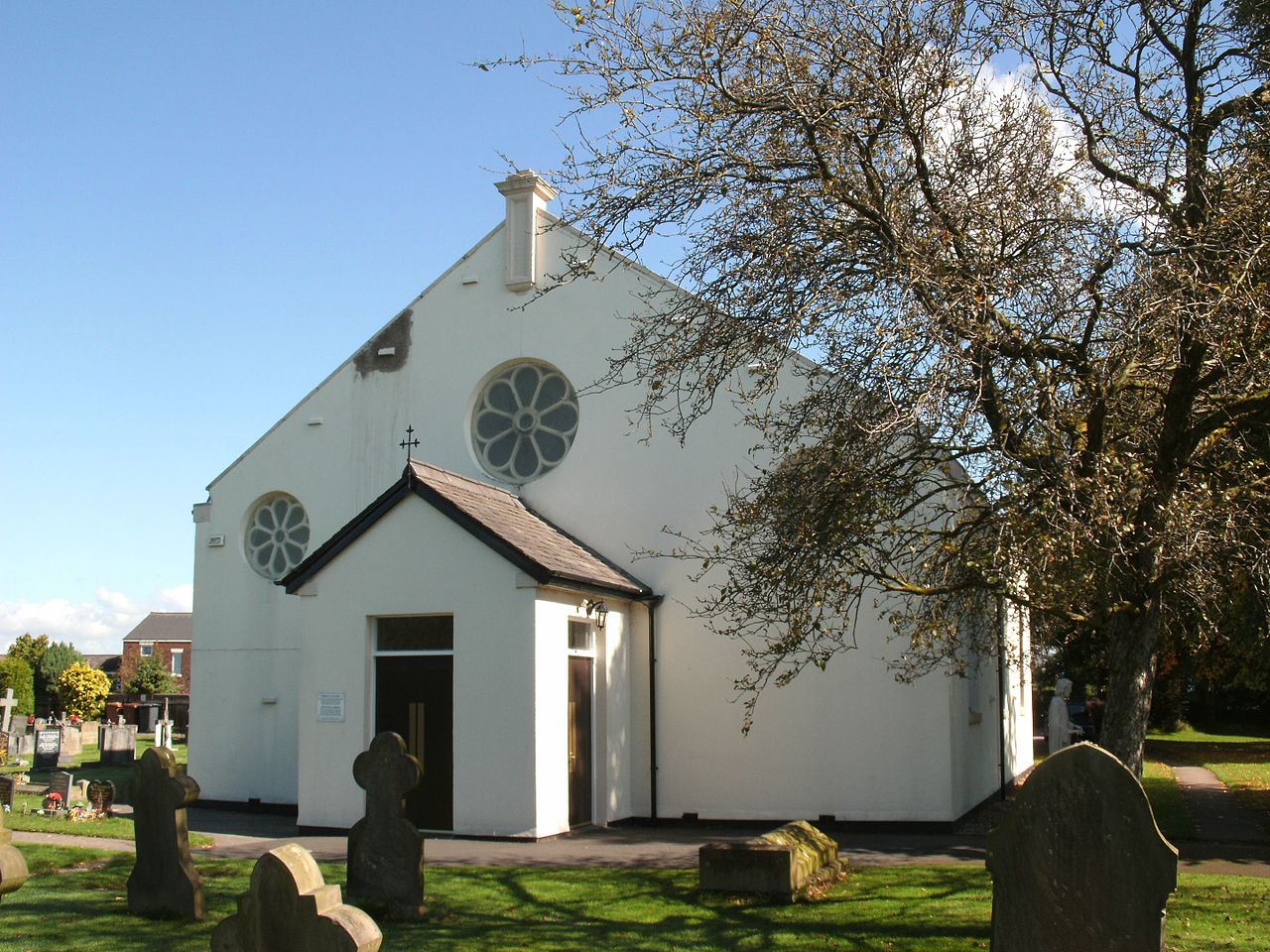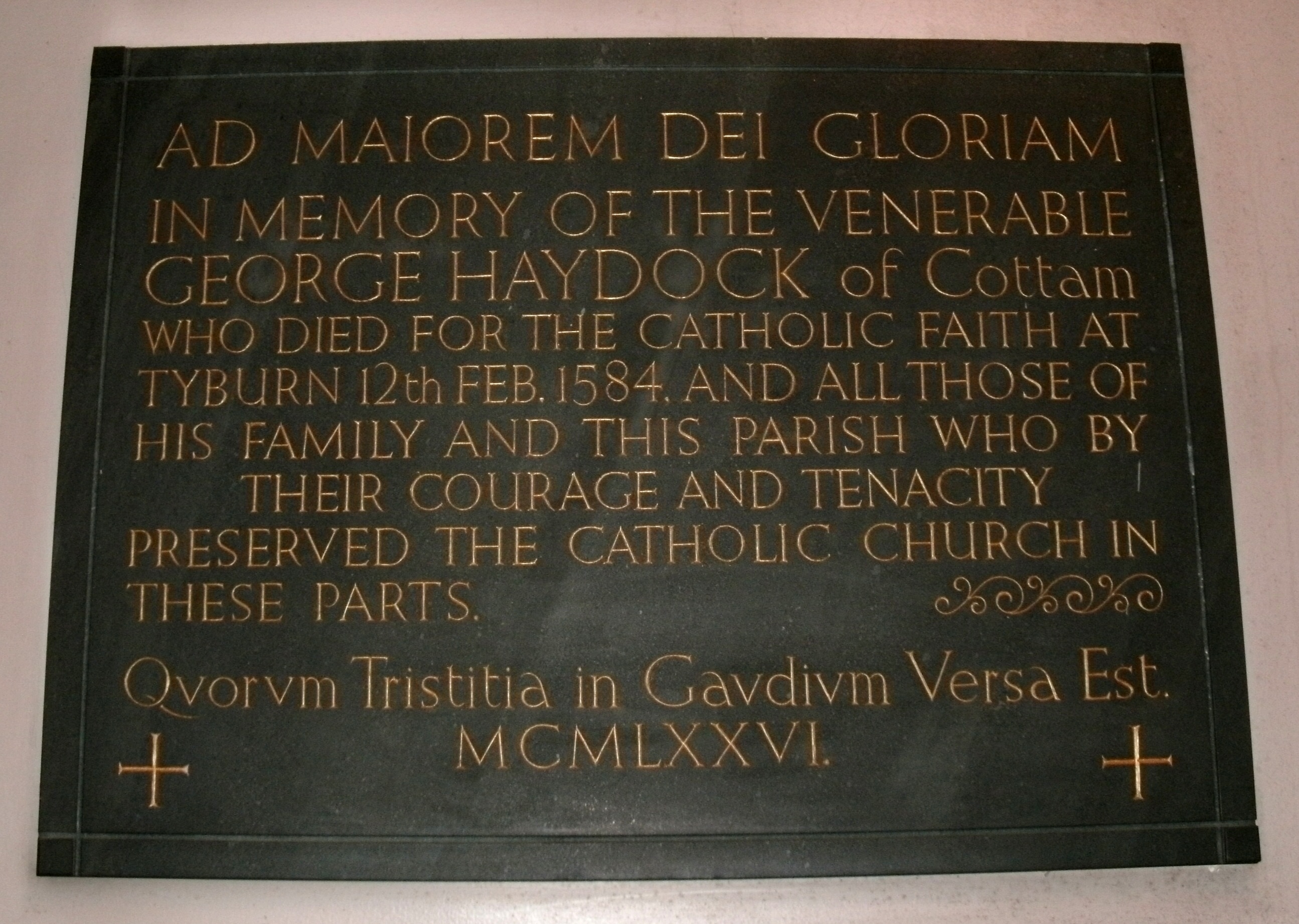
-St. Andrew’s & Blessed_George_Haydock’s Catholic Church, Cottam, Lancashire, UK
A group of Catholic male martyrs, aged between 24 and 80 years old, including George Haydock and sixty-two laypeople and religious. Sixty-three of these martyrs were ordained Catholic priests. Twenty-two were laypeople from various social ranks and walks of life.
These martyrs were arrested, tried, and executed particularly during the reign of Elizabeth I (r. 1558-1603) and Oliver Cromwell (r. 1653-1658), the Lord Protector, because they refused to accept statutes from these monarch/dictator that denied the Catholic Church’s role in their homeland.
George Haydock, singularly praised in this beatification, was born in 1556 at Cotton Hall, England, the son of Evan and Helen Haydock. He was sent to Douai, France, and then Rome, Italy, to be educated.
George was ordained a priest on December 21, 1581, probably at Reims, France. He returned to England to begin a missionary apostolate but was arrested soon after and placed in the Tower of London.He spent a year and three months in confinement in the Tower of London, suffering from a malarial fever he first contracted in the early summer of 1581 when visiting the seven churches of Rome.
About May, 1583, though he remained in the Tower, his imprisonment was relaxed to “free custody”, and he was able to administer the Sacraments to his fellow-prisoners. During the first period of his captivity he was accustomed to decorate his cell with the name and arms of the pope scratched or drawn in charcoal on the door or walls, and through his career his devotion to the papacy amounted to a passion. On 16 January 1584, he and other priests imprisoned in the Tower were examined at the Guildhall by the recorder touching their beliefs.
He frankly confessed, with reluctance, that he was eventually obliged to declare that the queen was a heretic, and so seal his fate. On 5 February 1584, he was indicted with James Fenn, a Somersetshire man, formerly fellow of Corpus Christi College, Oxford, William Deane who had been ordained priest the same day as himself, and six other priests, for having conspired against the queen at Reims, 23 September 1581, agreeing to come to England, 1 October, and setting out for England, 1 November. In point of fact he arrived at Reims on 1 November 1581.
On the same 5 February two further indictments were brought, the one against Thomas Hemerford, a Dorsetshire man, sometime scholar of St John’s College, Oxford, the other against John Munden, a Dorsetshire man, sometime fellow of New College, Oxford, John Nutter, a Lancashire man, sometime scholar of St John’s College, Cambridge, and two other priests. The next day, St Dorothy’s Day, Haydock, Fenn, Hemerford, Munden, and Nutter were brought to the bar and pleaded not guilty.
Haydock had for a long time shown a great devotion to St Dorothy, and was accustomed to commit himself and his actions to her daily protection. It may be that he first entered the college at Douai on that day in 1574-5, but this is uncertain. The Concertatio Ecclesiae says he was arrested on this day in 1581-2, but the Tower bills state that he was committed to the Tower on the 5th, in which case he was arrested on the 4th.
On Friday the 7th all five were found guilty, and sentenced to death. The other four were committed in shackles to “the pit” in the Tower. Haydock, perhaps in case he should die by a natural death, was sent back to his old quarters. Early on Wednesday the 12th he said Mass, and later the five priests were drawn to Tyburn on hurdles; Haydock, being probably the youngest and certainly the weakest in health, was the first to suffer. An eyewitness gave an account of their execution, which John Hungerford Pollen printed in the fifth volume of the Catholic Record Society.
Haydock was twenty-eight, Munden about forty, Fenn, a widower, with two children, was probably also about forty, Hemerford was probably about Haydock’s age; Nutter’s age is unknown.
Some of the better known martyred companions of George Haydock and the year they died are as follows:
William Carter (1584)
Hugh Grant (1585)
Marmaduke Bowes (1585)
Alexander Crow (1586 or 1587)
Nicholas Woodfen (1586)
William Pichard (1587)
Edmund Duke and Companions (1590)
Roger Thorpe (1591),
Thomas Watkinson (1591)
George Errington (1596)
William Gibson (1596)
Peter Snow (1598)
Ralph Grimstow (1598)
Christopher Wharton (1600)
Francis Ingleby (1586)
John Fingley (1586)
Robert Bickerdike (1586)
William Thomson (1586)
John Sandys (1586)
Richard Sargeant (1586)
John Lowe (1586)
Robert Dibdale (1586)
John Adams (1586)
Edmund Sykes (1587)
Stephen Rowsham (1587)
John Hambley (1587)
George Douglas (1587)
Richard Simpson (1588)
Edward Burden (1588)
Henry Webley (1588)
William Lampley (1588)
Nicholas Garlick (1588)
Robert Ludlam (1588)
Robert Sutton (1588)
Richard (Lloyd) Flower (1588)
William Spenser (1589)
Robert Hardesty (1589)
Thomas Belson (1589)
Richard Yaxley (1589)
George Nichols (1589)
Humphrey Pritchard (1589)
Nicholas Horner (1590)
Alexander Blake (1590)
George Beesley (1591)
William Pike (1591)
Mountford Scott (1591)
Joseph Lambton (1592)
Thomas Pormort (1592)
William Davies (1593)
Anthony Page (1593)
Christopher Robinson (1597)
John Bretton (1598)
Edward Thwing (1600)
Thomas Palaser (1600)
John Talbot (1600)
Robert Nutter (1600)
John Norton (1600)
Roger Filcock (1600)
Thomas Hunt (1600)
Thomas Sprott (1600)
Robert Middleton (1601)
Thurston Hunt (1601)
Robert Grissold (1604)
John Sugar (1604)
Robert Drury (1607)
Matthew Flathers (1608)
Roger Cadwallador (1610)
Thomas Atkinson (1616)
Roger Wrenno (1616)
John Thules (1616)
William Southerne (1618)
Thomas Bullaker (1642)
Henry Heath (1643)
Arthur Bell (1643)
Edward Bamber (1646)
John Woodcock (1646)
Thomas Whittaker (1646)
Nicholas Postage (1679)
and Charles Meeham (1679)
Pope St John Paul II beatified George Haydock and the other martyrs on November 22, 1987, The Solemnity of Jesus Christ the King of the Universe.
“This feast of Christ the King proclaims that all earthly power is ultimately from God, that His Kingdom is our first and lasting concern and that obedience to His laws is more important than any other obligation or loyalty.
Thomas More, that most English of saints, declared on the scaffold: “I die the King’s good servant but God’s servant first”. In this way he witnessed to the primacy of the Kingdom.
Today we have declared Blessed another eighty-five martyrs: from England, Scotland and Wales, and one from Ireland. Each of them chose to be “God’s servant First”. They consciously and willingly embraced death for love of Christ and the Church. They too chose the Kingdom above all else. If the price had to be death they would pay it with courage and joy.
Blessed Nicholas Postgate welcomed his execution “as a short cut to heaven”. Blessed Joseph Lambton encouraged those who were to die with him with the words “Let us be merry, for tomorrow I hope we shall have a heavenly breakfast”. Blessed Hugh Taylor, not knowing the day of his death, said: “How happy I should be if on this Friday, on which Christ died for me, I might encounter death for Him”. He was executed on that very day, Friday 6 November 1585. Blessed Henry Heath, who died in 1643, thanked the court for condemning him and giving him the “singular honour to die with Christ”.
Among these eighty-five martyrs we find priests and laymen, scholars and craftsmen. The oldest was in his eighties, and the youngest no more than twenty-four. There were among them a printer, a bartender, a stable-hand, a tailor. What unites them all is the sacrifice of their lives in the service of Christ their Lord.
The priests among them wished only to feed their people with the Bread of Life and with the Word of the Gospel. To do so meant risking their lives. But for them this price was small compared to the riches they could bring to their people in the Holy Sacrifice of the Mass.
The twenty-two laymen in this group of martyrs shared to the full the same love of the Eucharist. They, too, repeatedly risked their lives, working together with their priests, assisting, protecting and sheltering them. Laymen and priests worked together; together they stood on the scaffold and together welcomed death. Many women, too, not included today in this group of martyrs, suffered for their faith and died in prison. They have earned our undying admiration and remembrance.
These martyrs gave their lives for their loyalty to the authority of the Successor of Peter, who alone is Pastor of the whole flock. They also gave their lives for the unity of the Church, since they shared the Church’s faith, unaltered down the ages, that the Successor of Peter has been given the task of serving and ensuring “the unity of the flock of Christ”. He has been given by Christ the particular role of confirming the faith of his brethren.
The martyrs grasped the importance of that Petrine ministry. They gave their lives rather than deny this truth of their faith. Over the centuries the Church in England, Wales and Scotland has drawn inspiration from these martyrs and continues in love of the Mass and in faithful adherence to the Bishop of Rome. The same loyalty and faithfulness to the Pope is demonstrated today whenever the work of renewal in the Church is carried out in accordance with the teachings of the Second Vatican Council and in communion with the universal Church.
Central to this renewal, to which the Holy Spirit calls the Church, is work for that unity among Christians for which Christ Himself prayed. We must all rejoice that the hostilities between Christians, which so shaped the age of these martyrs, are over, replaced by fraternal love and mutual esteem.
Seventeen years ago [1970] forty of the glorious company of martyrs were canonized. It was the prayer of the Church on that day that the blood of those martyrs would be a source of healing for the divisions between Christians. Today we may fittingly give thanks for the progress made in the intervening years towards fuller communion between Anglicans and Catholics. We rejoice in the deeper understanding, broader collaboration and common witness that have taken place through the power of God.
In the days of the martyrs whom we honor today, there were other Christians who died for their beliefs. We can all now appreciate and respect their sacrifice. Let us respond together to the great challenge which confronts those who would preach the Gospel in our age. Let us be bold and united in our profession of our common Lord and Master, Jesus Christ.”
-plaque honoring Blessed George Haydock in St. Andrew’s & Blessed George Haydock’s Catholic Church, Cottam, Lancashire, UK.
“I pray God that my blood may increase the Catholic faith in England.” – Blessed George Haydock, speaking from the gallows
Blessed Martyrs of England, Scotland, Ireland, and Wales, pray for us!
Love,
Matthew

